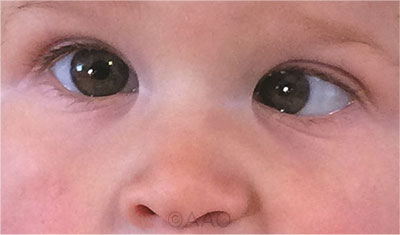Download PDF
Extraocular muscle injection of botulinum toxin type A (BTXA) achieves a high rate of successful motor alignment comparable to eye muscle surgery in children and adults with nonparalytic, nonrestrictive horizontal strabismus. The finding is in an Ophthalmic Technology Assessment (OTA) from the Academy.1
“BTXA is a good alternative to eye muscle surgery for certain clinical situations,” said Gil Binenbaum, MD, MSCE, at Children’s Hospital of Philadelphia. “Both modalities can successfully treat strabismus, and each approach has advantages and disadvantages that might make it preferable in a given situation.” Moreover, the evidence indicates that BTXA is effective as an alternative treatment for reoperations following prior eye muscle surgery, Dr. Binenbaum said.
 |
CANDIDATE? Most patients in the reviewed comparative studies had esotropia. Both esotropic and exotropic patients were represented in the case series.
|
Searching for evidence. For this OTA, the Pediatric Ophthalmology/Strabismus Panel conducted a systematic review of evidence that yielded 515 citations. Of these, 14 met inclusion criteria and were graded as either level II (n = 5) or level III (n = 9) evidence. No studies were graded as level I.
In children, the findings applied to both initial treatment and repeat treatment of strabismus after prior horizontal eye muscle surgery. Most patients in the comparative studies had esotropia.
Findings. Across four of the five level II comparative studies, success after Botox injections was relatively consistent at 60%, while success after surgery ranged from 66% to 77%. The fifth level II study reported significantly higher success with BTXA injection compared to surgery (94% vs. 72%).
In the level III case series, higher motor success rates of 87% to 89% were reported when children were treated in two muscles at a time. In adults treated with single injections, successful alignment rates were lower, suggesting that bilateral injections of BTXA may more effectively help to achieve the desired outcome.
Dosing. Although the doses used in the reviewed studies varied, in general, they were 2.5 to 5 units of BTXA injected into each muscle, with higher doses used for repeat injections. The number of sets of injections typically ranged from one to three—and for each set, one or two muscles were injected.
Side effects. Injection of BTXA appears to be relatively safe, with few or no lasting adverse effects, the OTA concluded. The most common side effects were transient ptosis and transient vertical strabismus; no blinding complications were reported.
An expected strabismus in the direction opposite of that being treated occurred in essentially all patients, but it resolved in most cases, as the BTXA effect dissipates over time.
Bottom line. “The literature clearly suggests that BTXA and eye muscle surgery have comparable motor success rates for basic strabismus,” Dr. Binenbaum said.
But further research, particularly from one or more well-designed randomized trials, is needed. As the OTA pointed out, “A study comparing time to desired alignment and binocular visual outcomes regardless of the number of eye muscle surgeries or sets of BTXA injections may help surgeons to understand better the relative benefits of either approach.”
In particular, Dr. Binenbaum noted, “there is limited evidence about sensory outcomes.” Moreover, when compared to eye muscle surgery, which achieves alignment quickly, it’s possible that the longer time frame needed for achieving good alignment with BTXA could negatively affect sensory outcomes, he said.
For now, Dr. Binenbaum is more open to considering BTXA in certain pediatric cases. “It is easy and quick to perform, it can work as well as eye muscle surgery, and for some children it may be preferable.”
—Miriam Karmel
___________________________
1 Binenbaum G et al. Ophthalmology. Published online June 24, 2021.
___________________________
Relevant financial disclosures—Dr. Binenbaum: Luminopia: O; X-Biomedical: O.
For full disclosures and the disclosure key, see below.
Full Financial Disclosures
Dr. Binenbaum Luminopia: O; X-Biomedical: O.
Dr. Kiss Adverum: C,O; Alcon: C,S; Allergan: S; Atara Biotherapeutics: P; Cornell University: P; Fortress Bio: O; Genentech/Roche: C,S; Novartis: C,S; Optos: C,S; Regeneron: S; Regenxbio: O. Intellectual property related to CTL treatment assigned to Cornell University.
Dr. Lee Klorfine Family Endowed Chair: S; National Institute on Aging: S; Research to Prevent Blindness: S.
Disclosure Category
|
Code
|
Description
|
| Consultant/Advisor |
C |
Consultant fee, paid advisory boards, or fees for attending a meeting. |
| Employee |
E |
Employed by a commercial company. |
| Speakers bureau |
L |
Lecture fees or honoraria, travel fees or reimbursements when speaking at the invitation of a commercial company. |
| Equity owner |
O |
Equity ownership/stock options in publicly or privately traded firms, excluding mutual funds. |
| Patents/Royalty |
P |
Patents and/or royalties for intellectual property. |
| Grant support |
S |
Grant support or other financial support to the investigator from all sources, including research support from government agencies (e.g., NIH), foundations, device manufacturers, and/or pharmaceutical companies. |
|
More from this month’s News in Review